
The British Commonwealth Air Training Plan (BCATP), or Empire Air Training Scheme (EATS) often referred to as simply "The Plan", was a massive, joint military aircrew training program created by the United Kingdom, Canada, Australia and New Zealand, during the Second World War. BCATP remains one of the single largest aviation training programs in history and was responsible for training nearly half the pilots, navigators, bomb aimers, air gunners, wireless operators and flight engineers who served with the Royal Air Force (RAF), Royal Navy Fleet Air Arm (FAA), Royal Australian Air Force (RAAF), Royal Canadian Air Force (RCAF) and Royal New Zealand Air Force (RNZAF) during the war.
Corps is a term used for several different kinds of organization. A military innovation by Napoleon I, the formation was first named as such in 1805. The size of a corps varies greatly, but two to five divisions and anywhere from 40,000 to 80,000 are the numbers stated by the US Department of Defense.
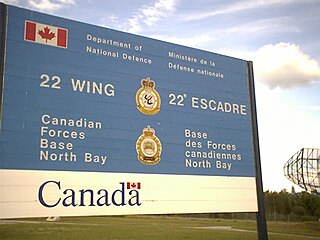
Canadian Forces Base North Bay, also CFB North Bay, is an air force base located at the City of North Bay, Ontario about 350 km (220 mi) north of Toronto. The base is subordinate to 1 Canadian Air Division, Winnipeg, Manitoba, and is the centre for North American Aerospace Defense Command (NORAD) operations in Canada, under the Canadian NORAD Region Headquarters, also in Winnipeg. It is also home to the 1 Air Force, Detachment 2 of the United States Air Force.

Canada has not officially maintained and possessed weapons of mass destruction since 1984 and, as of 1998, has signed treaties repudiating possession of them. Canada ratified the Geneva Protocol in 1930 and the Nuclear Non-proliferation Treaty in 1970.
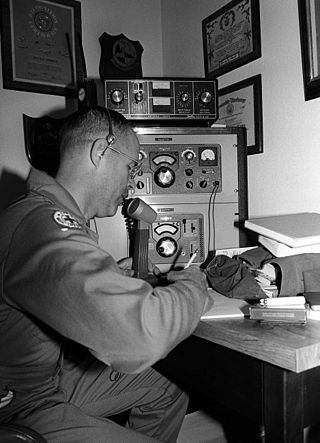
Auxiliaries are support personnel that assist the military or police but are organised differently from regular forces. Auxiliary may be military volunteers undertaking support functions or performing certain duties such as garrison troops, usually on a part-time basis. Unlike a military reserve force, an auxiliary force does not necessarily have the same degree of training or ranking structure as regular soldiers, and it may or may not be integrated into a fighting force. Some auxiliaries, however, are militias composed of former active duty military personnel and actually have better training and combat experience than their regular counterparts.

St. John's International Airport is in Newfoundland and Labrador, Canada. It is located 3 nautical miles northwest of St. John's, Newfoundland and Labrador and serves the St. John's metropolitan area and the Avalon Peninsula. The airport is part of the National Airports System, and is operated by St. John's International Airport Authority Inc.

Naval Station Argentia is a former base of the United States Navy that operated from 1941 to 1994. It was established in the community of Argentia in what was then the Dominion of Newfoundland, which later became the tenth Canadian province, Newfoundland and Labrador.
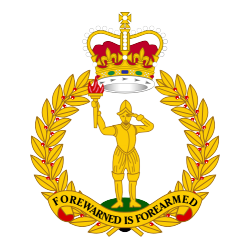
The Royal Observer Corps (ROC) was a civil defence organisation intended for the visual detection, identification, tracking and reporting of aircraft over Great Britain. It operated in the United Kingdom between 29 October 1925 and 31 December 1995, when the Corps' civilian volunteers were stood down. Composed mainly of civilian spare-time volunteers, ROC personnel wore a Royal Air Force (RAF) style uniform and latterly came under the administrative control of RAF Strike Command and the operational control of the Home Office. Civilian volunteers were trained and administered by a small cadre of professional full-time officers under the command of the Commandant Royal Observer Corps; latterly a serving RAF Air Commodore.

The history of Canada during World War II begins with the German invasion of Poland on 1 September 1939. While the Canadian Armed Forces were eventually active in nearly every theatre of war, most combat was centred in Italy, Northwestern Europe, and the North Atlantic. In all, some 1.1 million Canadians served in the Canadian Army, Royal Canadian Navy, Royal Canadian Air Force, out of a population that as of the 1941 Census had 11,506,655 people, and in forces across the empire, with approximately 42,000 killed and another 55,000 wounded. During the war, Canada was subject to direct attack in the Battle of the St. Lawrence, and in the shelling of a lighthouse at Estevan Point in British Columbia.
Pepperrell Air Force Base, previously known as Fort Pepperrell, is a decommissioned United States military base located in St. John's, Newfoundland, Canada which operated from 1941 to 1961.

Canadian Forces Base Gander, is a Canadian Forces base located in Gander, Newfoundland and Labrador. It is operated as an air force base by the Royal Canadian Air Force and is home to search and rescue operations that cover a vast swath of the western North Atlantic and southern Arctic and a Canadian Coastal Radar station amongst other things. It is home to 9 Wing Gander.

Pleaman Wellington Crummey JP (1891–1960) was a public figure in the Dominion of Newfoundland and the Province of Newfoundland. He was born at Western Bay, Conception Bay.
The Ground Observer Corps (GOC), sometimes erroneously referred to as the Ground Observation Corps, was the name of two American civil defense organizations during the middle 20th century.
The Aircraft Detection Corps Newfoundland was created by the Commission of Government of the Dominion of Newfoundland.

Canadian Forces Station Armstrong is a former General Surveillance Radar station. It is located 1.1 miles (1.8 km) east of Armstrong, Thunder Bay District, Ontario. It was closed in 1974.
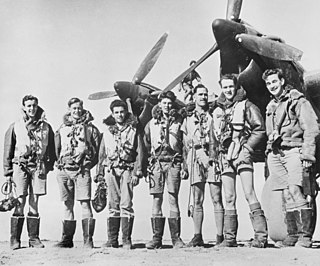
Article XV squadrons were Australian, Canadian, and New Zealand air force squadrons formed from graduates of the British Commonwealth Air Training Plan (1939) during World War II.

The Northeast Air Command (NEAC) was a short-lived organization in the United States Air Force tasked with the operation and defense of air bases in Greenland, Labrador and Newfoundland. It was formed in 1950 from the facilities of the United States established during World War II in Northeast Canada, Newfoundland and Greenland. It was discontinued in 1957.

Canada's Air Defence is a 33-minute 1957 Canadian documentary film produced by the National Film Board of Canada (NFB) for the Royal Canadian Air Force (RCAF). The film depicts the role of air defence over Canada and the United States by following the training and operational exercises of a RCAF squadron.
When the Second World War broke-out, the Dominion of Newfoundland was a Dominion governed directly from the United Kingdom via the Commission of Government. As Newfoundland was being administered by the Commission of Government, and had no functioning parliament, the British declaration of war on Germany automatically brought Newfoundland into a state of war with Germany on 3 September 1939.
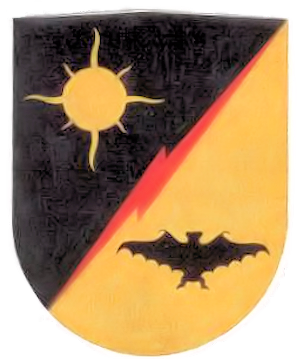
St. Bride's Radar Station was a United States Army General Surveillance Ground Radar Early Warning Station in the Dominion of Newfoundland. It was built during World War II and responsible for monitoring air traffic from Naval Station Argentia to RCAF Torbay and into the Atlantic Ocean. It was located in St. Bride's, 135 kilometres (84 mi) southwest of St. John's. It was closed in 1945.














